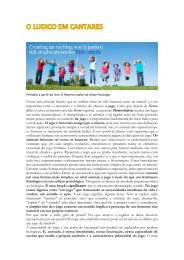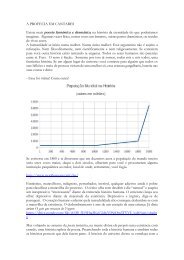Motherhood in Childhood
You also want an ePaper? Increase the reach of your titles
YUMPU automatically turns print PDFs into web optimized ePapers that Google loves.
overlooked by policymakers and development<br />
programmes everywhere. A deeper understand<strong>in</strong>g<br />
of the challenges confront<strong>in</strong>g 10 to 14-year-olds<br />
is urgently needed, and pregnancy prevention and<br />
support for very young adolescent mothers must<br />
be advanced to the top of the sexual and reproductive<br />
health and reproductive rights agenda of<br />
governments, development <strong>in</strong>stitutions and civil<br />
society. It is with this group that the greatest need<br />
lies and that the obstacles have been thus far<br />
<strong>in</strong>surmountable.<br />
1 Reach girls ages 10 to 14<br />
Intervene early with preventive measures<br />
The needs, vulnerabilities and challenges of<br />
very young adolescents—between ages 10 and<br />
14—are often overlooked by policymakers. But<br />
<strong>in</strong>terventions at this critical stage of their development,<br />
characterized by profound physical,<br />
cognitive and social changes that occur <strong>in</strong> puberty,<br />
are needed to ensure girls’ safe and healthy<br />
transition through adolescence <strong>in</strong>to adulthood.<br />
Governments, communities and civil society<br />
should seize opportunities aris<strong>in</strong>g dur<strong>in</strong>g this<br />
formative period to beg<strong>in</strong> lay<strong>in</strong>g the foundations<br />
for girls’ sexual and reproductive health and<br />
reproductive rights—and enjoyment of all their<br />
human rights <strong>in</strong> the long run. Strategic tim<strong>in</strong>g<br />
of preventive <strong>in</strong>terventions, <strong>in</strong>clud<strong>in</strong>g the provision<br />
of age-appropriate comprehensive sexuality<br />
education and steps to enable girls to attend and<br />
rema<strong>in</strong> <strong>in</strong> school, allows for positive outcomes<br />
before the circumstances of young adolescents’<br />
lives are set.<br />
Give visibility to girls traditionally <strong>in</strong>visible to<br />
policymakers<br />
Effective policymak<strong>in</strong>g has been hampered <strong>in</strong><br />
many countries by a dearth of data and contex-<br />
“My uncle slept with me. I don’t<br />
go to school anymore. At school,<br />
they do not accept girls who<br />
become pregnant.”<br />
Affoué, 13, Côte d’Ivoire<br />
tual <strong>in</strong>formation about very young adolescents.<br />
Researchers and policymakers should jo<strong>in</strong> forces<br />
to fill this data void to ensure very young adolescents<br />
are not overlooked by or excluded from<br />
services and to ensure their rights are protected.<br />
National censuses and future household<br />
surveys should <strong>in</strong>clude a basic set of questions<br />
about 10 to 14-year-olds. These questions<br />
should address whether biological parents are<br />
alive and liv<strong>in</strong>g <strong>in</strong> the household, whether the<br />
adolescents are married or already parents themselves,<br />
how much education they have atta<strong>in</strong>ed<br />
and whether they are still <strong>in</strong> school, and whether<br />
they hold jobs or work outside the home. Where<br />
such data exist, they should be easily accessible,<br />
and be analysed separately from data on older<br />
adolescent girls.<br />
At the same time, data on younger and older<br />
adolescent girls should be comb<strong>in</strong>ed to identify<br />
and highlight the trajectory from childhood<br />
through adolescence to adulthood. Such an analysis<br />
reveals critical junctures <strong>in</strong> the lives of girls<br />
that are preceded by critical <strong>in</strong>vestment w<strong>in</strong>dows.<br />
Such data and analyses when presented to<br />
stakeholders can be used to <strong>in</strong>form policy and<br />
programme priorities, ensure properly weighted<br />
resource allocation, <strong>in</strong>fluence programme design<br />
THE STATE OF WORLD POPULATION 2013<br />
85

















